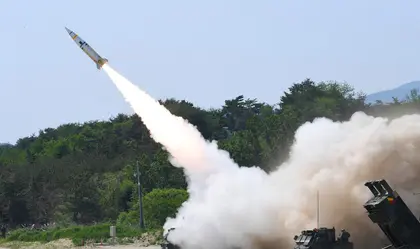On a trip to the White House on Monday, NATO Secretary General Jens Stoltenberg told US President Joe Biden that 23 of the Alliance’s 32 members would meet a 10-year-old pledge to spend at least two percent of GDP on defense.
“NATO allies are this year increasing defense spending by 18 percent. That’s the biggest increase in decades,” Stoltenberg said at a press conference following a meeting with Biden in the Oval Office.
JOIN US ON TELEGRAM
Follow our coverage of the war on the @Kyivpost_official.
NATO members agreed to the two-percent goal at a 2014 summit at about the same time that Russia had illegally annexed Crimea. At that time, only the US, Britain, and the once-debt-laden country of Greece had met that mark. (While Athens had struggled over the past decade to keep debt below EU-imposed limits, the country had always punched above its weight in military obligations due to its age-old territorial disagreements with Turkey.)
Stoltenberg had last reported that around 20 allies were meeting the target, AFP noted, with many Northern and Central European member states (Germany, especially) increasing military budgets due to Russia’s unprovoked full-scale invasion of Ukraine in 2022.
Latvia sends first batch of UAVs as part of larger “Drone Coalition”
Latvian Defense Minister Andris Spruds said in an interview with a military media outlet that his country is sending the first shipment of drones to Ukraine as part of the international “Drone Coalition” which has raised about €549 million ($589 million) for the project.

Inside the South Korean Weapons Factory That Could Supply Kyiv
This shipment from Riga is worth about €20 million ($21.5 million). Other countries involved in the project include Canada, Germany, Estonia, the Netherlands, Sweden and the UK. Latvia has spearheaded the initiative ever since Spruds visited Kyiv last December.
“Latvia has prepared a batch of drones and they have already been sent. Now we are already collecting the second batch of drones, which is soon to be sent to Ukraine,” Spruds told the military new site ArmyInform. “So, the next step is to use this funding effectively, and we are doing it on several levels,” Spruds said.
“Ukraine can use it in accordance with its military-strategic assessments and needs,” he added, clarifying that there are no restrictions on the intended targets, even inside Russian territory.
In the early hours of Monday, Ukrainian military intelligence officials said, Kyiv’s drones targeted military facilities in Russia within 250 miles of the Ukrainian border. Russian state media outlet Astra reported that a pipeline had been damaged in a metallurgy plant in Lipetsk.
Drones have played a crucial role in the defense of Kharkiv in recent days, with one Russian soldier named Anton Andreev telling Astra:
“They just chop us up. We are sent under machine guns, under drones in daylight, like meat. And commanders just shout ‘forward and forward’.”
Recent figures say 22 injured in Russian missile strike on Poltava
A Russian cruise missile struck the city of Poltava about 140 km southwest of Kharkiv Monday afternoon, injuring at least 22 civilians.
“Early reports say that the enemy struck the civilian infrastructure with a Kh-59 cruise missile,” the Poltava regional prosecutor’s office announced. The officials went on to describe that the cruise missile (which has a range of about 200 km) damaged a kindergarten, residential buildings and power lines.
At least six children were among the injured, the prosecutor’s office said, including one who was hospitalized.
More than 50,000 homes were left without power, early reports indicated.
British intel projects new tax hikes in Russia will boost coffers by $29 billion
The latest intelligence update from the UK Ministry of Defense stated that the Kremlin’s recent tax hikes will take in about 2.6 trillion additional rubles in 2025, the equivalent of about $29 billion. The funds will “almost certainly” go to at least in part to the war, the Ministry said.
Corporate taxes are slated to go from 20 percent to 25 percent, while the highest income bracket in Russia will scale up to 22 percent from 15.
“The increased tax burden on businesses will almost certainly restrict future investment and growth of non-military sectors,” the update reads. “Russia’s economic growth is highly likely being driven by high state investment into the military sectors of the economy.”
Despite increasing sanctions on the Kremlin, Russia’s economy ministry forecasts GDP growth for 2024 will hit about 2.8 percent.
Putin continues his purge of Defense Ministry leadership
On Monday, Russian President Vladimir Putin replaced four deputy defense ministers with a new guard of loyal associates: one of his relatives, the son of a former prime minister, and a finance expert, continuing the Kremlin leader’s trend of loading up the Ministry with economists.
Putin dismissed Nikolai Pankov, Ruslan Tsalikov, Tatiana Shevtsova, and Army General Pavel Popov, and replaced them with Anna Tsivileva, Pavel Fradkov, and Leonid Gornin.
Tsivileva is Putin’s first cousin once removed, the Institute for the Study of War (ISW) noted. Fradkov is the son of former prime minister Mikhail Fradkov, and Gornin had previously served as the First Deputy Minister of Finance, starting in May 2018.
“These appointments suggest that Putin is prioritizing the appointment of officials whom he deems to be loyal to the regime and economists to improve Russia’s defense industrial base,” ISW analysts wrote.
In May, Putin replaced Defense Minister Sergei Shoigu with former First Deputy Prime Minister Andrei Belousov, an economist.
You can also highlight the text and press Ctrl + Enter









